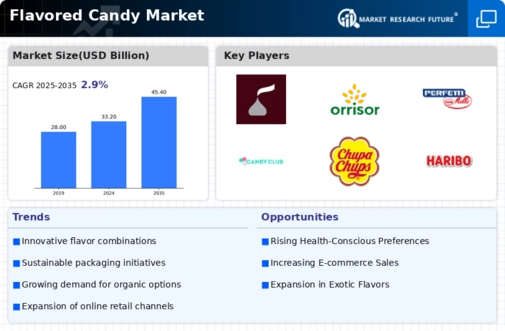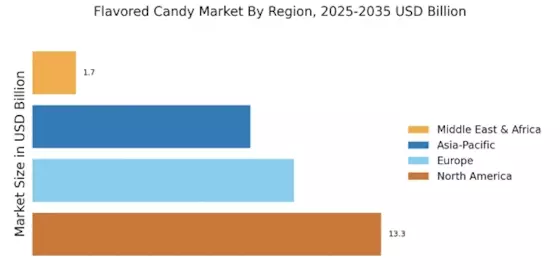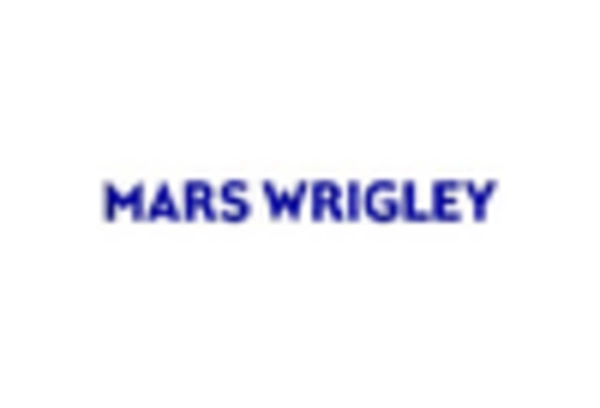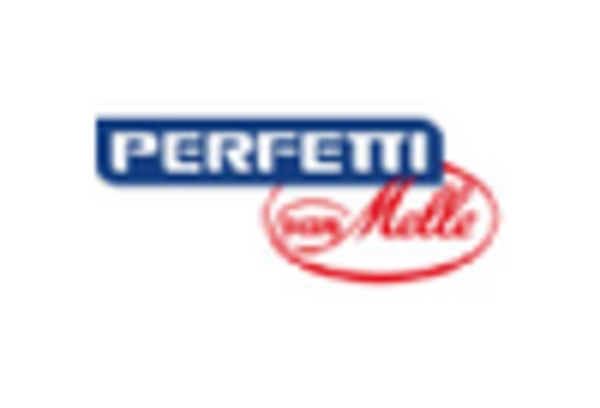Expansion of Retail Channels
The Flavored Candy Market is benefiting from the expansion of retail channels, including convenience stores, specialty shops, and online platforms. This diversification allows consumers greater access to a wide variety of flavored candies, catering to different preferences and occasions. Data indicates that e-commerce sales in the candy sector have seen a substantial rise, with online purchases accounting for nearly 20% of total sales. This trend is particularly appealing to younger consumers who favor the convenience of online shopping. As retailers adapt to changing consumer behaviors, the availability of flavored candies across multiple channels is likely to enhance overall market growth. Companies that strategically position their products in both physical and digital spaces are poised to capitalize on this expanding market.
Innovative Flavor Combinations
The Flavored Candy Market is witnessing a surge in innovative flavor combinations that appeal to diverse consumer preferences. Manufacturers are increasingly experimenting with unique blends, such as spicy-sweet or savory-sour profiles, to attract adventurous consumers. This trend is supported by data indicating that nearly 60% of consumers express interest in trying new flavors. As a result, companies are investing in research and development to create distinctive offerings that stand out in a crowded marketplace. The introduction of limited-edition flavors also plays a crucial role in driving sales, as consumers are often drawn to novelty and exclusivity. This dynamic fosters a competitive environment where brands strive to differentiate themselves through creativity and originality.
Sustainability and Ethical Sourcing
Sustainability has emerged as a pivotal driver in the Flavored Candy Market, with consumers increasingly prioritizing products that align with their values. Brands are responding by adopting sustainable practices, such as using ethically sourced ingredients and eco-friendly packaging. Research indicates that approximately 70% of consumers are willing to pay a premium for products that are environmentally friendly. This shift not only enhances brand loyalty but also attracts a broader customer base. Companies that emphasize transparency in their sourcing and production processes are likely to gain a competitive edge. As sustainability becomes a core aspect of consumer decision-making, the Flavored Candy Market is expected to evolve, with brands that fail to adapt potentially losing market share.
Growing Demand for Sugar-Free Options
The Flavored Candy Market is experiencing a notable increase in demand for sugar-free options, driven by health-conscious consumers seeking alternatives to traditional sugary candies. Data suggests that the sugar-free candy segment is projected to grow at a compound annual growth rate of over 5% in the coming years. This trend is particularly pronounced among individuals with dietary restrictions, such as diabetics or those following low-carb diets. Manufacturers are responding by developing innovative formulations that maintain flavor while reducing sugar content. The rise of natural sweeteners, such as stevia and erythritol, has further facilitated this shift. As the market adapts to these changing consumer preferences, brands that offer appealing sugar-free options are likely to thrive.
Influence of Social Media and Marketing
The Flavored Candy Market is significantly influenced by social media and digital marketing strategies. Brands are leveraging platforms like Instagram and TikTok to engage with younger audiences, showcasing visually appealing products that encourage sharing and interaction. This trend is supported by data indicating that over 50% of consumers discover new products through social media channels. Influencer partnerships and user-generated content play a crucial role in shaping consumer perceptions and driving purchase decisions. As brands invest in targeted marketing campaigns, the ability to create buzz around new flavors or limited editions becomes essential. Consequently, the Flavored Candy Market is evolving, with companies that effectively harness the power of social media likely to see increased brand visibility and sales.


















Leave a Comment